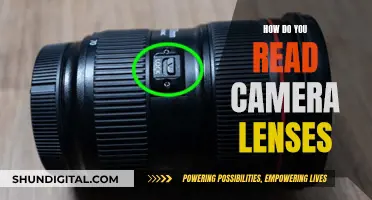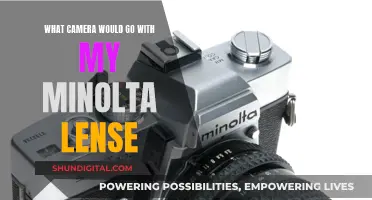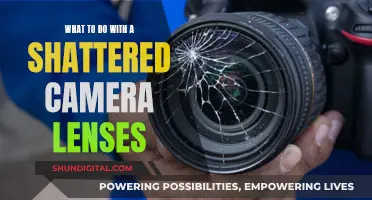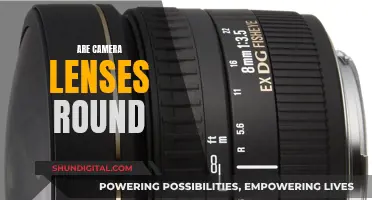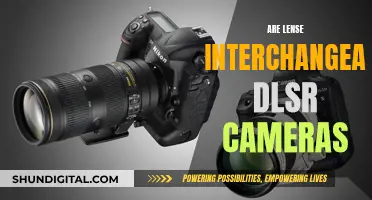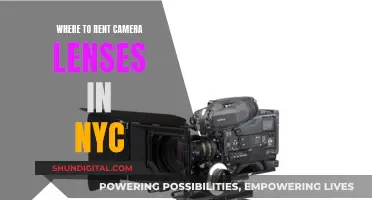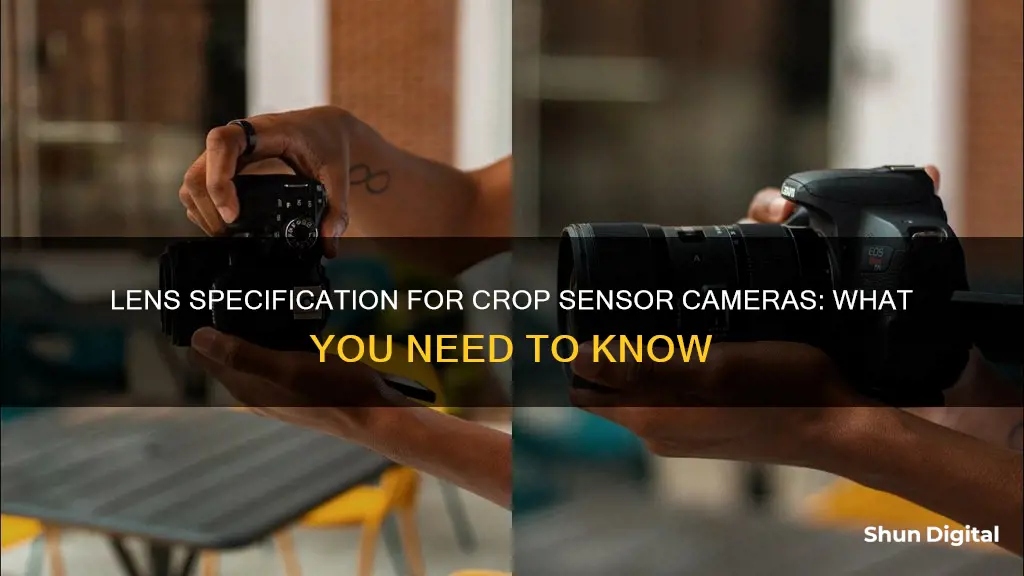
Lenses for crop sensor cameras are specified by their focal length and maximum aperture. The focal length of a lens determines how close or far objects appear in the frame, with higher focal lengths bringing distant objects closer. The maximum aperture, or f-stop, represents the size of the iris or hole in the lens, with larger apertures allowing more light in and thus requiring a faster shutter speed. When selecting lenses for crop sensor cameras, it is important to consider the crop factor, which affects the field of view and effective focal length. The crop factor varies depending on the camera brand and model, and can impact the choice of lenses for a particular style of photography.
What You'll Learn

Focal length and aperture
Focal Length
The focal length of a lens is the distance along the lens's optically central axis (beginning at the rear nodal point) to the image plane in the camera when the lens is focused at infinity. In other words, it is the distance at which light rays converge to form a sharp image on the digital sensor at the focal plane in the camera.
The higher the focal length, the closer distant objects seem. For example, sports photographers and bird watchers typically want much larger focal lengths to get in close. Lower numbers, on the other hand, widen the field of view to make more things fit within the image (wide-angle lenses) and are often the tools of the trade for landscape photographers.
Aperture
Aperture is the size of the opening in the lens. It is expressed as a ratio of the focal length to the diameter of the aperture opening, commonly referred to as an f/number, f/stop, focal ratio, f/ratio, or relative aperture. Lenses with variable apertures allow photographers to control the amount of light entering the lens.
The aperture f-stop number represents the size of the iris or hole in the lens. A lens will be rated based on the largest aperture the iris can open. Larger maximum aperture lenses, which let in more light, are called faster lenses. For example, an f/2.8 lens is considered pretty fast, while an f/5.6 lens is considered pretty slow.
The crop factor of a camera is the ratio of the dimensions of its imaging area compared to a reference format, most often the 35 mm film format. The crop factor is used to compare the field of view and image quality of different cameras with the same lens.
When a lens designed for a full-frame camera is used on a crop sensor camera, the field of view is correspondingly smaller because a smaller area of the image circle cast by the lens is used by the smaller imaging area. The focal length of the lens does not change, but the effective focal length is multiplied by the crop factor to find the focal length that would yield the same field of view as the reference format.
For example, a 50mm lens on a camera with a crop factor of 1.6 will yield the same field of view as an 80mm lens on a full-frame camera. The aperture and ISO settings also need to be adjusted with respect to the crop factor to capture an image with the same field of view and image quality.
It is important to note that the crop factor does not affect a lens's focal length or aperture. The focal length will not change just because you have a larger or smaller sensor. However, sensor size does have an effect on depth of field, but not because it changes the aperture.
When considering a crop sensor camera, it is important to understand how the crop factor will impact the effective focal length and aperture of your lenses. By multiplying the lens's focal length by the crop factor, you can determine the equivalent focal length on a full-frame camera. This will help you choose the right lenses for your crop sensor camera to achieve the desired field of view and image quality.
Motorized Telescoping Lenses: Are They Reliable Camera Companions?
You may want to see also

Camera body and lens combinations
When it comes to camera body and lens combinations, there are a few key considerations to keep in mind. Firstly, it's important to understand that different camera brands use different lens mount systems, which means that lenses from one brand may not be compatible with camera bodies from another brand. Some brands, like Olympus and Panasonic, share a lens mount system, allowing for more flexibility in lens and body combinations. Additionally, third-party lens manufacturers like Sigma and Tamron produce lenses for multiple camera mounts, expanding the options available to photographers.
When choosing a camera body and lens combination, it's crucial to consider the sensor size. The two most popular sensor sizes are cropped and full-frame sensors. Full-frame sensors, like the one found in a 35mm film camera, offer a wider field of view and better low-light performance due to their larger size. Cropped sensors, on the other hand, introduce a crop factor, resulting in a tighter field of view. This can be advantageous in certain scenarios, like wildlife or sports photography, where you need extra reach. However, it also makes wide-angle shots more challenging.
Another factor to consider when pairing camera bodies and lenses is the focal length. Lenses with longer focal lengths are often favoured by sports photographers and bird watchers, as they bring distant objects closer. On the other hand, lenses with shorter focal lengths are ideal for landscape photographers as they widen the field of view. Additionally, the aperture of the lens plays a crucial role in determining the amount of light that enters the camera and the depth of field. Lenses with larger maximum apertures, denoted by lower f-stop numbers like f/2.8, are considered faster lenses as they allow for quicker shutter speeds.
When investing in camera equipment, it's essential to consider the long-term use and potential upgrades. Lenses tend to last longer than camera bodies, so it's worth investing in high-quality glass that will work across different camera bodies. Additionally, full-frame lenses can be used on crop sensor camera bodies, but they may not perform optimally due to the smaller sensor size. It's important to note that the crop factor of the camera body will affect the effective focal length of the lens. For example, a 50mm lens on a crop sensor camera with a 1.5x crop factor will have an effective focal length of 75mm.
When deciding on a camera body and lens combination, it's beneficial to consider the specific photography goals and budget. Crop sensor cameras are generally more affordable and portable, making them a great starting point for beginners or those on a tighter budget. On the other hand, full-frame cameras offer higher image quality, dynamic range, and low-light performance, making them the industry standard for working professionals. Ultimately, the choice between a crop sensor and a full-frame camera depends on the photographer's individual needs and preferences.
Camera Lenses: Waterproof or Not?
You may want to see also

Full-frame vs crop sensor
When choosing a camera, one of the first and most important decisions you'll have to make is what sensor size to use. In digital photography, the two main categories of cameras are those with cropped sensors and those with full-frame sensors. Here's a detailed comparison of the two to help you decide which one suits your needs.
Full-Frame Sensors
Full-frame sensors are the same size as a piece of 35mm film, measuring 24mm x 36mm. They offer the following advantages:
- Wider angles: Full-frame sensors can capture more light, a larger image circle, and a wider field of view.
- Larger photosites: The larger surface area of full-frame sensors means they have bigger photosites (light collectors on the sensor) that record pixels, resulting in less digital noise and diffraction in your images.
- Greater creative control: The larger sensors allow for a shallower depth of field, enabling you to achieve a blurred background (bokeh effect) more easily.
- Better dynamic range: Full-frame sensors offer a greater transitional tonal value, greater tonal accuracy, and better colour accuracy.
- Better low-light performance: With a full-frame sensor, you can shoot in low-light conditions without having to increase the ISO as much, resulting in better image quality.
- Higher overall image quality: Full-frame sensors capture more light and detail, resulting in sharper and clearer images with less noise and more dynamic range.
However, full-frame sensors also come with some disadvantages:
- Heavier and bulkier: Full-frame cameras tend to be larger and heavier than crop sensor cameras, making them less portable.
- More expensive: Full-frame sensors are significantly more expensive, and you'll also need to invest in full-frame lenses, which can be pricier than the camera body itself.
- Larger file sizes: Full-frame sensors capture more data, resulting in larger image files that require more storage space.
Crop Sensors
Crop sensors are smaller than the standard 35mm size, with the most common type being the APS-C format. They offer several benefits:
- Lighter and more portable: Smaller sensors result in smaller and lighter cameras, making them easier to carry around, especially when paired with lighter lenses.
- Magnified view: Crop sensors capture a central section of the image, creating a magnified effect that is advantageous for telephoto photography, such as sports, wildlife, or nature photography.
- More affordable: Crop sensors are less expensive because they are smaller and cost less to manufacture.
- Smaller image files: Crop sensors capture less data, resulting in smaller image files that are easier to manage and store.
However, there are also some drawbacks to consider:
- Tighter focal length: Crop sensors have limitations when it comes to capturing wide-angle shots, and using extra-wide-angle lenses may introduce distortion at the edges of your images.
- Lower low-light performance: Crop sensors let in less light, so you'll need to increase the ISO in low-light conditions, which can lead to more noise in your images.
- Lower image quality: The smaller sensor size results in smaller photosites, which can affect dynamic range, tonal accuracy, and overall image quality.
Both full-frame and crop sensor cameras have their strengths and weaknesses, and the right choice depends on your specific needs and goals as a photographer. Full-frame sensors offer higher image quality, better low-light performance, and more creative control, but they come with a higher price tag and increased bulk. On the other hand, crop sensors are more affordable, lightweight, and ideal for capturing magnified images at a distance, but they may fall short in terms of image quality and low-light performance. Ultimately, the decision should be based on your budget, the type of photography you plan to do, and your personal preferences for image quality and portability.
Black Friday Camera Lens Deals: What to Expect
You may want to see also

Sensor size
The sensor is the physical rectangle in the centre of your DSLR camera that reads the image from the lens. The size of the sensor is one of the most important factors when deciding which digital camera to buy.
The two most popular sensor sizes are cropped and full frame. A full-frame camera has a sensor the size of a 35mm film camera (24mm x 36mm). A crop sensor is any sensor that is smaller than this standard 35mm size.
A larger sensor will generally lead to higher image quality as it allows more light and detail to be captured. This is why full-frame cameras are considered the industry standard for working professionals. However, there are pros and cons to each sensor size, and depending on your photography goals, you might find that a crop sensor camera is a better option.
Full-frame cameras tend to be bulkier, heavier, and more expensive than crop sensor cameras. They also produce larger image files, which means you'll need to invest in more storage.
Crop sensor cameras are usually cheaper, smaller, and lighter. They also produce smaller image files, which can be beneficial in terms of file management and storage capacity. However, a crop sensor can't fit the same amount of information into a file as a full frame, and this may be noticeable in certain situations, such as low-light conditions.
The two most common crop sensor sizes are APS-C and Micro Four Thirds, which have crop factors of 1.6x and 1.5x respectively. Canon APS-C sensors are slightly smaller than those offered by most other manufacturers, with a crop factor of 1.6x. Nikon, Sony, Sigma, and Pentax APS-C sensors have a crop factor of 1.5x.
What Camera Lenses Are Made Of: Metal or Myth?
You may want to see also

Lens optics
The lens is a crucial component of any camera system, and understanding lens optics is essential for photographers, especially when dealing with crop sensor cameras.
When light passes through a lens, it gets inverted, flipping the image upside down before it projects onto the digital sensor. This process is fundamental to how we capture images.
Lenses are defined by their focal length and maximum aperture. The focal length determines how close or distant objects appear in the frame. For example, sports photographers or bird watchers would require longer focal lengths to get closer to the action. On the other hand, landscape photographers often use lower focal lengths to widen the field of view and capture more of the scene.
The aperture, represented as an f-stop number, indicates the size of the iris or hole in the lens. A larger aperture, such as f/2.8, lets in more light and is considered a "faster" lens. This is because a larger aperture requires a faster shutter speed to expose the image correctly.
It's important to note that focal length is not a measure of the physical length of the lens but rather the optical distance at which light converges to form a sharp image on the sensor. The aperture, on the other hand, is directly related to the focal length, as a longer focal length will result in a smaller aperture.
When choosing lenses, it's essential to consider the camera's sensor size. Crop sensor cameras have smaller sensors than their full-frame counterparts, introducing a crop factor that affects the field of view. This can be advantageous in certain situations, such as wildlife or sports photography, as it provides extra reach. However, it also makes wide-angle shots more challenging due to the tighter field of view.
Additionally, the crop factor impacts the effective focal length of the lens. For example, a 50mm lens on a crop sensor camera with a 1.5x crop factor will result in an effective focal length of 75mm. This effect is more pronounced on crop sensors with larger crop factors.
When it comes to lens optics, it's crucial to understand the relationship between the lens and the camera sensor. The round shape of lenses projects a circular image, while the sensor is rectangular or square. As a result, all cameras will cut off parts of the image, typically the edges. Camera manufacturers design their lenses and sensors to ensure optimal coverage, but using a lens designed for a different sensor size can result in image quality issues.
While crop sensor cameras offer advantages in terms of cost, portability, and extra reach, they may not perform as well in low-light conditions compared to full-frame cameras. This is because the smaller sensor collects less light, resulting in noisier images with lower dynamic range.
In conclusion, understanding lens optics and how they interact with crop sensors is vital for photographers to make informed decisions about their equipment. By considering factors such as focal length, aperture, and sensor size, photographers can choose the right lenses for their crop sensor cameras to achieve their desired results.
Camera Lens Imperfections: Do Scratches and Marks Affect Quality?
You may want to see also
Frequently asked questions
All digital cameras are classified by their sensor size, with the two most popular sizes being full-frame and crop. A full-frame camera has a larger sensor, which allows for more light and detail to be captured, resulting in higher image quality. Crop sensor cameras have smaller sensors, which introduce a crop factor that crops the edges of photos for a tighter field of view.
The crop factor affects the focal length of the lens used. For example, if a 50mm lens is used on a crop sensor camera with a 1.5x multiplier effect, the effective focal length becomes equivalent to a 75mm lens. This results in a narrower field of view compared to a full-frame sensor.
Full-frame cameras offer several benefits, including:
- Higher dynamic range, allowing for better exposure and higher contrast images.
- Superior low-light performance with less noise and more detail.
- Shallower depth of field, enabling a more pronounced blurred background effect.
- Higher resolution and detail, making them ideal for commercial photography and large-format printing.
- Wider field of view, which is advantageous for landscape, real estate, and architecture photography.
Yes, full-frame cameras tend to be more expensive, bulkier, and require larger storage options due to the increased file sizes.
Crop sensor cameras are generally more affordable, compact, and lightweight, making them a good choice for beginners or those seeking portability. The crop factor can also provide extra reach for certain types of photography, such as wildlife or sports photography.


